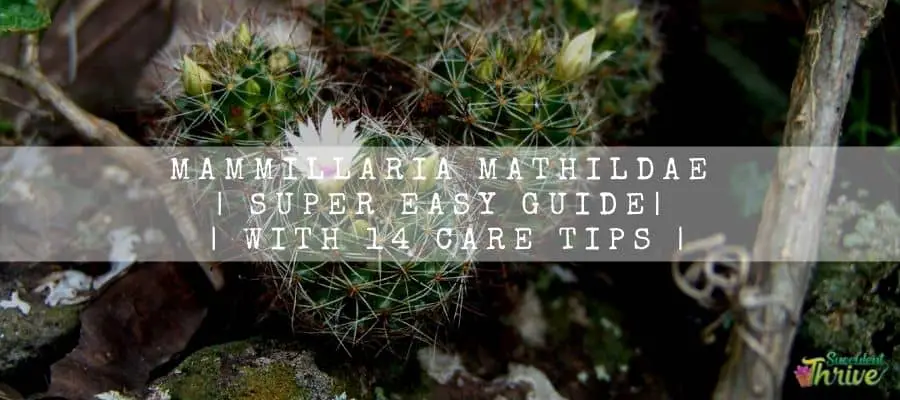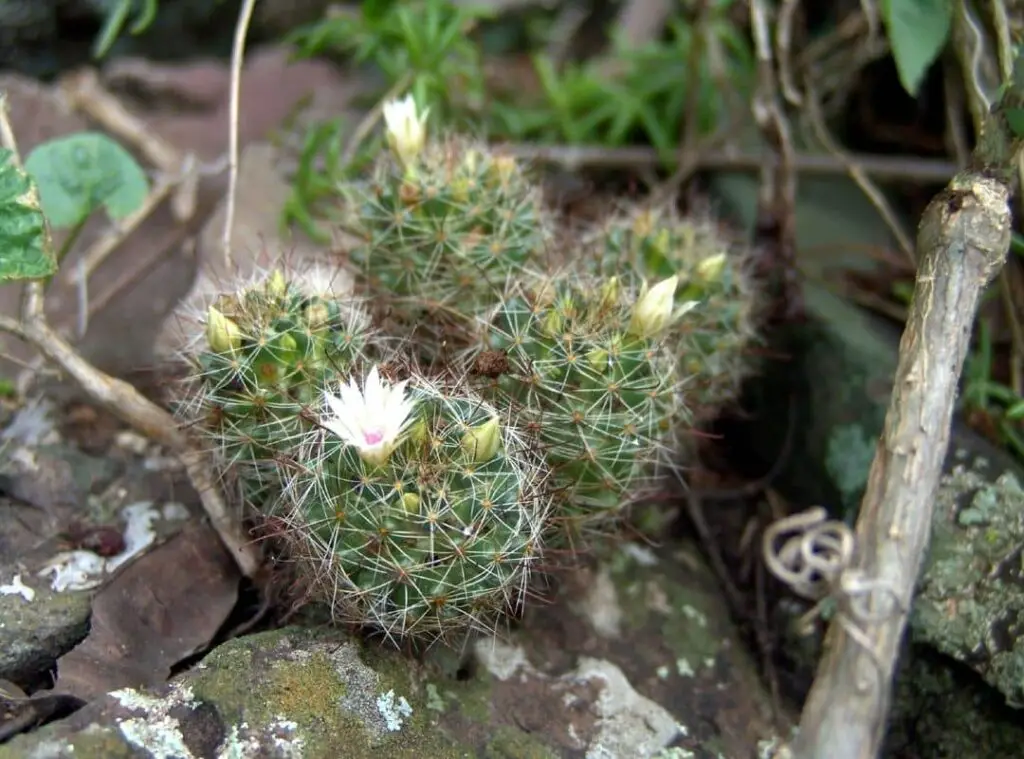Mammillaria mathildae cactus belong to the Cactaceae family and an endemic plant in Mexico. Their natural habitat would be mostly the tropical deciduous forests and the crasicayle scrubs.
In fact, Mammillaria mathildae cactus is further regarded as an endangered species. These plants are running out of the habitat and that has become the main reason for their extinction.

How do I identify a Mammillaria mathildae?
You could identify the Mammillaria mathildae cactus from its look.
In general, they are fleshy to the touch and tend to take a globose shape. They are a set of perennial plants, and you could spot them in dark green in color.
Size
Mammillaria mathildae in their natural habitat would be about 6 cm in height. In addition to that, they would further consist with spines as well.
Those spines would be either radial or central. However, they will comprise about 11 radial spines and with one central spine. The spines would be reddish brown in color, and end in a hook.
One look care guide
| Botanical Name | Mammillaria mathildae |
| Common Name | Not specified |
| Plant Type | Cactus |
| Mature Size | 6 cm in height |
| Sun Exposure | Full sunlight to partial sunlight |
| Soil Type | Well draining |
| Soil pH | 6.1 to 6.5 (mildly acidic) |
| Bloom Time | After the first summer rain |
| Flower Color | White |
| Hardiness Zones | 8 to 10 |
| Native Area | Mexico |
| Toxicity | Non toxic |
How do you take care of a Mammillaria mathildae?
Light Requirement
Mammillaria mathildae would require only a little maintenance from you.
When it comes to taking care of these Mammillaria mathildae cactus, you should provide strong light. That would make a great impact in keeping the plant healthy and vigorous.
Ideally it has to be bright sunlight during morning hours and partial sunlight during afternoon hours.
If you are growing them as indoor plants, best is to locate them near a window sill so that they could gain as much light as they want.
Alternatively, you could place them outdoors during summer and shift them indoors when the weather conditions change.
Temperature and humidity
These plants would prefer to grow in heated temperatures. Ideally, they have to be around 70-80 degrees Fahrenheit.
They would go dormant during the winter season, and you may reduce the temperature requirements depending on that.
Ideally you could keep them in a cooler area during this period. Flowering of the Mammillaria mathildae cactus would be benefitted by that.
Is it cold hardy?
Mammillaria mathildae cactus are not cold hardy.
USDA Hardiness Zone
This plant is found in USDA hardiness zone 8 to 10.
Watering Requirement
In terms of watering the Mammillaria mathildae, you should always see whether the top layer of the soil surface is dry to the touch.
If you feel the soil is soggy, best is to wait for some more days and after that water them.
If you are unsure whether you should water or not, I would always recommend waiting for some days and then water, simply because there could be worse repercussions made from over watering rather than what you do with under watering.
In addition to that, you should ensure that the soil is entirely dry in between two watering sessions. When you water, do it thoroughly.
Do not ever leave your Mammillaria mathildae roots in wet and soggy conditions as it could be lethal on the plant.
You could skip watering them during the winter season as that is their dormancy period. Having said that, if you feel like the plant is appearing to be shriveled or dry, you could slightly mist them.

Soil Requirement Type / pH
Mammillaria mathildae cactus soil requirements are the same as the rest of other cactus and succulents soil requirements.
The crucial thing when selecting the right soil mix is that you need to ascertain whether it is well draining.
You could go for a succulent soil mix or even for a cactus soil mix which would perfectly fit in for this purpose. It includes coarse sand, perlite which would be quite effective to better the drainage of the plant.
On the other hand, you should go ahead and plant them in a pot which has enough draining holes so that excess water could move through without getting retained in the pot.
You could grow them in a terracotta pot for best results.
Flowering and Fragrance
Mammillaria mathildae would bloom with white colors and they would further consist with a pink center as well.
Pot size Potting and Repotting
In terms of repotting the Mammillaria mathildae, you could do it if it is essential only. Best season to do it would be summer.
However, to do repotting, first you should check whether the soil is dry. If it is dry, you could simply take the plant out from the pot.
After that get rid of the older soil around the plant and you could remove the damaged and the rotten roots from the plant.
After that you could place the plant in the pot whilst making sure the roots are well spaced out in the pot.
When you plant it, make sure that it is grown in the same depth as in the older pot. Once you complete all these, you could leave the plant until it dries for about one weeks’ time.
Finally, you could water them lightly so that it would reduce the risk of root rot.
Where to Plant
Mammillaria mathildae should be planted in a well-draining soil mix and make sure they get adequate levels of sunlight as well.
If you have grown them outdoors, you could grow them in a small pot which you could bring indoors when the weather conditions get worse.
If you are growing them indoors, a windowsill would be the best location to place them.
Fertilizer and time of year
Mammillaria mathildae would require a fertilizer in their actively growing season which is summer. You may use a liquid fertilizer when feeding them.
You could use a fertilizer which is specifically made for succulents and for cacti. Avid feeding them during winter and in fall since those seasons would be their dormancy.
Dormancy
Mammillaria mathildae are winter and fall dormant plants.
Can it be toxic to pets?
There are no reports to say whether these Mammillaria mathildae are toxic for humans or for pets.

Common bugs and illness issues
You will have to encounter bugs such as mealybugs, red spider mites’ aphids’ scales when growing these plants.
It is vital that you attend to these bug attacks then and there unless they could make severe repercussions on the plant.
Mealybugs are the most commonly spotted bug when growing these plants, they could be so annoying since you cannot spot them to your naked eye at once.
In addition to that, root rot would be the most concerning problem which you will go through when taking care of it.
That is why it is important that you water them properly since if you over water them, there is a high probability of having root rot in your plant.
Special Care tips
There is nothing special you have to do when taking care of them since what is important is to provide their basic requirements only.
Avoid over watering the plants as it could create so many unwanted issues which could turn out to be deadly on the plants.
How do you propagate a Mammillaria mathildae?
You can use seed or grafting methods to propagate this cactus.
Read more about Mammillaria propagation : Pincushion Cactus Propagation Guide | 10 Minutes Quick Read |
Mammillaria mathildae plant benefits
With their unique and beautiful characters they would be great picks for indoor as well as outdoor gardening.
Related questions
Is Mammillaria mathildae an indoor plant?
Yeah, you could grow Mammillaria mathildae as indoor plants. But keep in mind to provide adequest sunlight to the plant as they love sunlight.
Also keep the plant away from children and pets. There is nor record of its toxicity, but it is wise to keep the plant away from children and pets.
Do Mammillaria mathildaes need direct sunlight?
They would prefer to have Full sunlight and partial sunlight. It does not need to be direct sunlight.
Should I mist my Mammillaria mathildae?
I would encourage you to do a light misting when growing them.
Read More: Burro’s Tail vs Donkey Tail | Are They Similar? | 5 Minutes Reading
